‘Shadows in time: Crosswall revisited’
Ian Blair
The ‘City Wall at Vine Street’ is the newest museum to open in the City of London and features a substantial extant section of the Roman City wall and the foundations of an adjoining extramural bastion: City Wall at Vine Street .
These impressive remains were discovered in 1979 on the Department of Urban Archaeology (DUA) excavation at 8-10 Crosswall (XWL79) supervised by John Maloney.
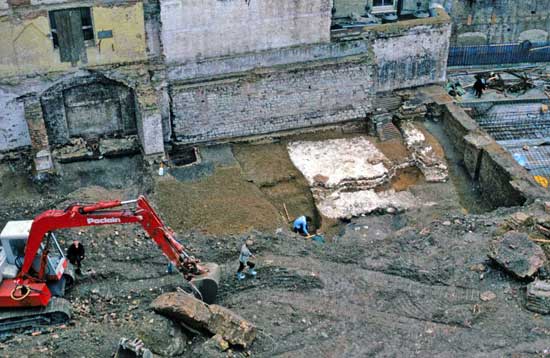 Aerial view of the on-going excavation of the Roman city wall and bastion at Crosswall (looking west) © MOLA
Aerial view of the on-going excavation of the Roman city wall and bastion at Crosswall (looking west) © MOLA
In 1905, the inner (west facing) side of the city wall at this location had been exposed and subsequently preserved in the basement of the new Roman Wall House. Seventy-four years later, work began on demolishing the neighbouring Metropolitan Bonded Warehouse to the east, which had stood on the site since 1863. Following the demolition of the building, a small team of DUA archaeologists began a targeted excavation on the site, with an initial priority being to remove the modern plaster render from the party wall in the basement, to reveal the external face of the city wall: which had as hoped survived.
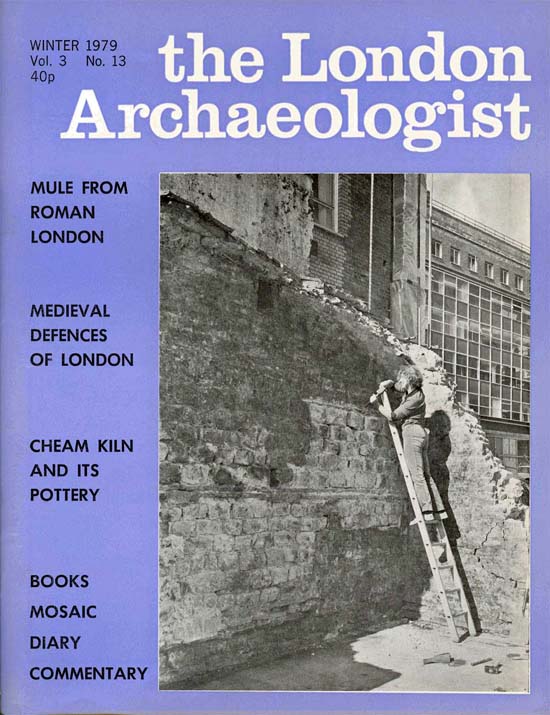 ‘Front page news’: Marie Barker chipping away the modern plaster render that concealed the outer face of the Roman City wall in advance of the excavation at Crosswall
‘Front page news’: Marie Barker chipping away the modern plaster render that concealed the outer face of the Roman City wall in advance of the excavation at Crosswall
London Archaeologist
One element that was completely unforeseen was the discovery of the foundations of a hitherto unknown Roman bastion immediately in front of this newly revealed stretch of the city wall, the footings composed of alternating courses of rammed-chalk and rough-hewn ragstone. Although the superstructure of the bastion had been systematically robbed and razed to the ground by the thirteenth century, a small cluster of faced blocks from its basal course were found in-situ including a fragment of an inscribed Roman tombstone.
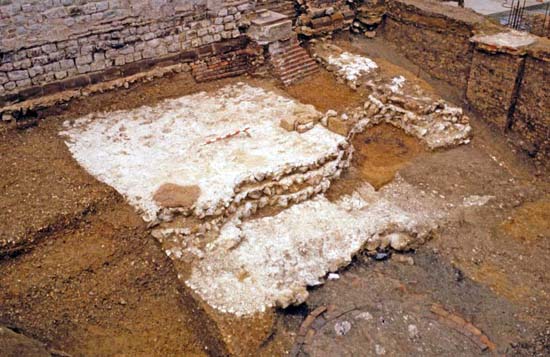 Roman bastion 4A as found showing the few surviving blocks of the basal course of the inner core of its superstructure which included a fragment of an inscribed Roman tombstone © MOLA
Roman bastion 4A as found showing the few surviving blocks of the basal course of the inner core of its superstructure which included a fragment of an inscribed Roman tombstone © MOLA
To fit this new bastion within the existing numbered sequence that runs in an anti-clockwise direction from the Tower of London, it was labelled Bastion 4A.
Not having seen the remains since I helped uncover them in 1979, and with the successive building having come and gone in the interim, I was intrigued to see the new museum and accompanying display. Set in an open airy space with natural light flooding in on the remains from two sides it looks very good, with an extensive finds display in cabinets ranged along one side of the space.
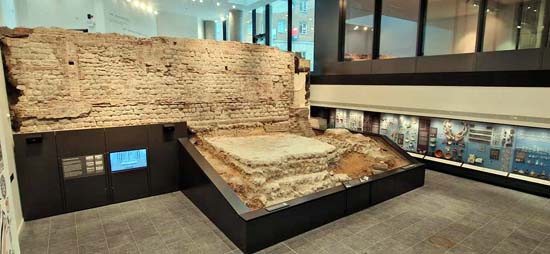 The new ‘City Wall at Vine Street’ museum display of the Roman city wall and bastion 4A © Ian Blair
The new ‘City Wall at Vine Street’ museum display of the Roman city wall and bastion 4A © Ian Blair
Whereas the Roman city wall and the bastion are largely as I remember them, it is a shame that a good deal of the striking chamfered red ferruginous sandstone plinth to the wall south of the bastion, which marks the contemporary Roman ground surface when the wall was built, is now concealed.
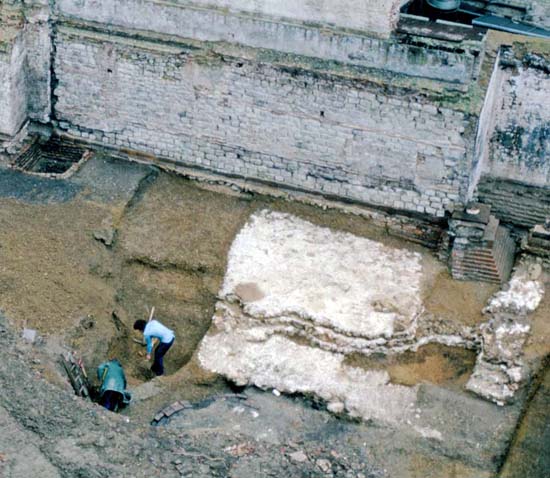 The Roman wall and bastion during the excavation. Ian Blair and Geoff Egan (at bottom left) are excavating a section through the V-cut defensive ditch contemporary with the wall. The foundation of the later Roman bastion was stepped and purposely deepened where it overlay the earlier ditch © MOLA
The Roman wall and bastion during the excavation. Ian Blair and Geoff Egan (at bottom left) are excavating a section through the V-cut defensive ditch contemporary with the wall. The foundation of the later Roman bastion was stepped and purposely deepened where it overlay the earlier ditch © MOLA
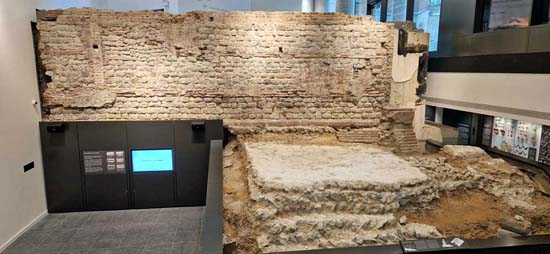 The Roman wall and bastion as newly displayed: compare to the previous photo of the remains as excavated, and the now concealed section of the chamfered sandstone plinth © Ian Blair
The Roman wall and bastion as newly displayed: compare to the previous photo of the remains as excavated, and the now concealed section of the chamfered sandstone plinth © Ian Blair
I had never seen the opposing inner side of the wall: which is an interesting hybrid between a modern art installation, that would not look out of place in Tate Modern, and an ancient monument. This is due to the complex engineering required to support the massive remains of the wall through multiple redevelopments and the lowering of successive basements since Roman Wall House was constructed.
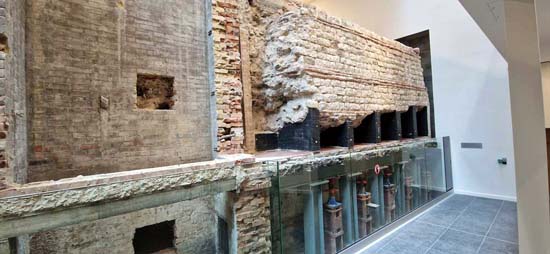 The inner face of the Roman city wall and modern support structures in the new display at ‘City Wall at Vine Street’ museum © Ian Blair
The inner face of the Roman city wall and modern support structures in the new display at ‘City Wall at Vine Street’ museum © Ian Blair
Whilst writing this post I came across a reference to an antiquarian photograph of the wall as found on Roman Wall House in 1905 which is reproduced in the Royal Commission Roman London volume published in 1928. Having dug out my copy, I realise that my use of the term ‘complex engineering to support the massive remains of the wall’ is somewhat exaggerated: at least at the point of discovery, as the whole structure had been completely undermined and was solely supported on two wooden posts. That it survived at all to be part of the new museum over a century later is a minor miracle.
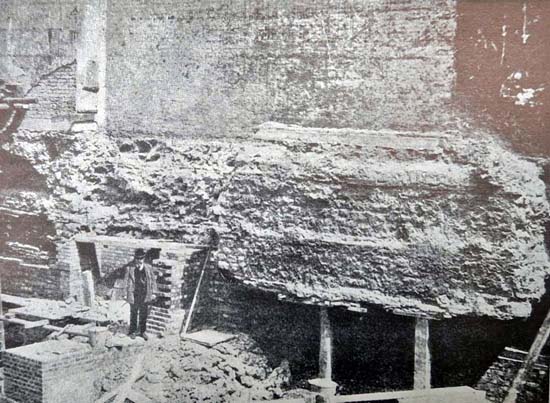 View of the undermined internal face of the Roman city wall as exposed during the construction of Roman Wall House in 1905. Photo originally published in Archaeologia, LX
View of the undermined internal face of the Roman city wall as exposed during the construction of Roman Wall House in 1905. Photo originally published in Archaeologia, LX
As well as working on the Crosswall site, I was lucky enough over a six-year period to work on two other extramural excavations that revealed extant sections of the Roman City Wall: 6-7 Crescent (CST85) supervised by Andrew Westman in 1985, and Capel House, Old Broad Street (CAP86), which I supervised in 1986. There is something incredibly evocative about working on a site where the Roman City wall forms an imposing backdrop to an excavation being undertaken in its shadow. We are indeed all but mere shadows in time.
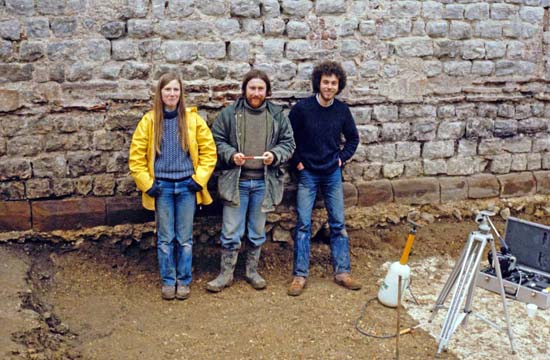 ‘We are all shadows in time’: Cath Maloney, Geoff Egan, and Ian Blair with their backs to the wall (Scale 0.2m) © MOLA
‘We are all shadows in time’: Cath Maloney, Geoff Egan, and Ian Blair with their backs to the wall (Scale 0.2m) © MOLA
The discovery of Bastion 4A in the City of London and its implications :
https://www.hobleysheroes.co.uk/images/Lamas-pdfs/31_Bastion4a_LMS_80.pdf

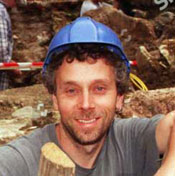

Comments powered by CComment